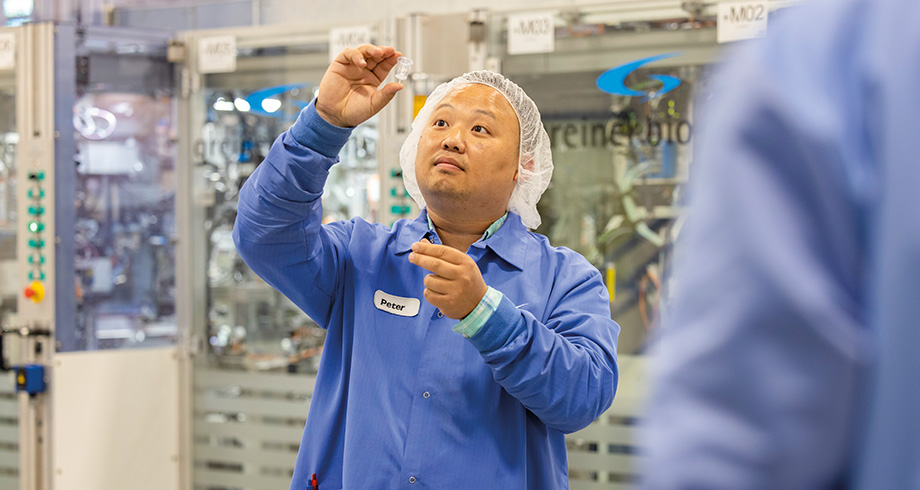Slamming on the CO2 brakes
A global catastrophe is looming. We, the global community, are heating up the planet as a result of our skyrocketing CO2 emissions. It is estimated that more than two trillion tonnes of CO2 have been released into the atmosphere since the end of the 19th century. A higher concentration of CO2 means higher temperatures. That is how simple the equation of the climate crisis is. The repercussions of the climate crisis are already making themselves felt and are no longer merely a theoretical threat facing the future: storms, torrential rainfall, droughts, heat waves – we are seeing all of these events more and more frequently. The climate has already warmed up significantly. Temperatures in the Arctic have already risen by two degrees, and they are continuing to increase. Arctic ice sheets have been shrinking for years. The smaller and smaller area covered by ice, especially in summer, acts as an indicator for climate change. It is a visual reminder that we need to change course.

“Ultimately, the goal needs to be clear: We need carbon neutral companies that act responsibly.”
Faster and more aggressive switch
Climate change has not only just begun – we have been right at the center of it for a long time. The Earth today is already about one degree warmer than it was 100 years ago. Even if we manage to massively cut our emissions, temperatures on Earth will continue to rise after emissions stop. They will fall only if we are able to successfully harness technological innovations to remove CO2 from the atmosphere on a large scale. At the moment, however, this is not a feasible option. At the same time, the global ecosystem will be thrown out of balance if certain temperatures are exceeded.
There are tipping points that, if exceeded, will have an irreversible impact on the global climate with devastating consequences. These tipping points include the Greenland ice sheet, the permafrost ground in Siberia and the Amazonian rainforest. If we, as the global community, want to limit global warming to no more than 1.5 degrees, we need to rapidly slam on the CO2 brakes. If annual emissions remain at current levels, we do not even have another nine years before we cannot emit any more CO2. Yet even if we succeed in drastically reducing CO2 emissions extremely quickly, massive repercussions will still be felt across all parts of the world. No matter what, sea levels will rise by at least 30 centimeters by 2100.
Nevertheless, the 1.5 degrees Celsius limit can be met if we reduce our greenhouse gas emissions by 50 percent in the next ten years and to zero by 2050. How can this be achieved? The answer is simple yet challenging to implement: The only way to achieve this is to radically change our existing economic model and our economy as a whole. Companies like us play a central role in this. Hiding or shirking away are not an option. We, the business community, also have to actively play our part. It is important here to realize that the climate crisis also offers enormous opportunities for companies like us, as well as risks. This is because the impact of climate change on the economy and on society is multifarious.
Global warming brings with it conventional business risks such as supply bottlenecks, supply chain disruption and damage to production sites as a result of extreme weather events. Yet these may also be compounded by new business risks if society’s response to climate change creates new technologies, markets and legal requirements that incur costs or directly affect existing products, services and assets. Nonetheless, it also opens up numerous opportunities. For example, companies can improve their energy efficiency and therefore reduce costs. Climate change also promotes innovations aimed at reducing CO2 and that make companies less reliant on fluctuations in the prices of fossil raw materials. The latter strengthens competitiveness and opens up new market opportunities for companies.
More and more people can see and understand the consequences of the climate crisis and so they are taking to the streets and protesting against actions that damage the climate and in favor of a new, lower-emission and thus environmentally friendly world. Increased awareness has also led to changes in what is expected of companies in recent years. Consumers, politicians and civil society stakeholders are – quickly rightly – calling for companies to announce how they will reduce their emissions. Ultimately, the goal needs to be clear: We need carbon neutral companies that act responsibly. This decade represents a particular challenge as there is little time left and we have to make the switch from a high-emissions to a low-emissions economy this decade.
Paris Climate Agreement
The Paris Agreement is a legally binding international treaty on climate change. It was adopted by 196 parties at COP 21 in Paris, on December 12, 2015 and entered into force on November 4, 2016.
The goal:
To limit global warming to well below 2, preferably to 1.5 degrees Celsius, compared to pre-industrial levels. To achieve this long-term temperature goal, countries aim to reach global peaking of greenhouse gas emissions as soon as possible to achieve a carbon neutral world by mid-century.
The stages:
The Paris Agreement is a landmark in the multilateral climate change process because, for the first time, a binding agreement brings all nations into a common cause to undertake ambitious efforts to combat climate change and adapt to its effects. Implementation of the Paris Agreement requires economic and social transformation. The Paris Agreement works on a 5- year cycle of increasingly ambitious climate action carried out by countries.
Moving away from coal, gas and crude oil
As a company, we are partly responsible for more CO2 being released into the environment than the planet can handle. This is because, in the manufacturing sector, our energy requirements are too often met by burning coal, gas or crude oil. Producing the materials we process at Greiner also generates emissions. The targets that we set ourselves as part of our Blue Plan sustainability strategy start right here. Even more importantly, they go hand in hand. A functioning circular economy, for example, uses fewer resources and thus generates fewer emissions than a linear industry. Increased use of secondary materials reduces our emissions and helps protect the climate. Emissions are also generated as a result of using and disposing of our products. These two areas are also the focus of our measures and ambitions. Structural and profound changes in many areas – including consumption, mobility, production and agriculture – and increased technological development in the areas of energy efficiency and renewable energy sources are crucial to providing an answer to the climate crisis. Both companies and consumers across the world have a responsibility here, no matter how complex and difficult the transition may seem. It has to happen fast and with a force with which we have never before unleashed as a global society.
Becoming a carbon neutral company
As a manufacturing company, our business activities create emissions. The energy required to produce innovative and sustainable products results in emissions from various sources. Our aim is to reduce Scope 1 and 2 emissions by 2030 so that our company’s production is carbon neutral. We define carbon neutrality as no longer generating any Scope 1 or Scope 2 greenhouse gas emissions or offsetting these emissions in full. We intend to achieve this by focusing on three areas:
- Avoiding emissions and improving our energy efficiency,
- using renewable, low-emission energy,
- offsetting the remaining greenhouse gas emissions.
Management systems are a key tool in our path to increasing our energy efficiency as they allow us to identify potential for improvement and better manage change processes. Six sites introduced a certified management system in accordance with ISO 50001 and 31 sites introduced an environmental management system in accordance with ISO 14001 in 2020. As described in our first sustainability report, we strive to continually expand the management systems.
Production sites with certified management systems
|
|
2018 |
|
2020 |
|---|---|---|---|---|
Environment as per ISO 14001 |
|
0 / 9 |
|
0 / 9 |
Energy as per ISO 50001 |
|
1 / 9 |
|
1 / 9 |
|
|
2018 |
|
2020 |
|---|---|---|---|---|
Environment as per ISO 14001 |
|
17 / 22 |
|
17 / 22 |
Energy as per ISO 50001 |
|
0 / 22 |
|
1 / 22 |
|
|
2018 |
|
2020 |
|---|---|---|---|---|
Environment as per ISO 14001 |
|
6 / 16 |
|
14 / 23 |
Energy as per ISO 50001 |
|
2 / 16 |
|
4 / 23 |
|
|
2018 |
|
2020 |
|---|---|---|---|---|
Environment as per ISO 14001 |
|
0 / 8 |
|
0 / 8 |
Energy as per ISO 50001 |
|
0 / 8 |
|
0 / 8 |
A structured approach and ongoing reviews of our processes are essential to achieving our group sustainability targets. We have developed a hierarchy in order to step up the expansion of management systems: At the top of this is establishing a quality management system. Sites that already have quality management systems in accordance with ISO 9001 should implement an environmental management system in accordance with ISO 14001. Building on this, all sites are to adopt ISO 50001 and then establish ISO 45001. Step for step, this provides a structure for all production sites to expand management systems. Through this hierarchy, we want in particular to account for the fact that all production sites are starting from a different base. In 2018, 42 percent of our production sites worldwide had an environmental management system according to ISO 14001. By 2020, this had already reached 50 percent. This increase is due primarily to our foam division NEVEON. At NEVEON, the Eurofoam sites were integrated into the reporting framework for the first time in 2020, resulting in this positive development. The number of energy management systems also increased slightly following the Eurofoam takeover. While only just under 5 percent of sites were ISO 50001 certified in 2018, by 2020 this had risen to 10 percent of production sites.
Green energy revolution needed
To achieve our target of carbon neutrality, we will have to step up our share of renewable energy. Our total energy requirement in 2020 was 529,785 MWh.
Total energy consumption (MWh)
Greiner
Total energy consumption is made up of our purchased energy consumption for electricity, heating and cooling, direct energy consumption in production and fuel consumption. Greiner requires fuel both for production and for the vehicle fleet. Although it already uses some electric forklifts and electric cars form part of the vehicle fleet at three sites, the vast majority still run on fossil fuels. No renewable fuels are in use at present. Steam power has not been purchased at any Greiner production site.
Total electricity consumption by division (MWh)
Greiner Bio-One
Greiner Packaging
NEVEON
Greiner Extrusion

Peter Xiong (Greiner Bio-One)
Production Manager Assistant
Kremsmünster (Greiner Bio-One)
Savings: 1,337 MWh (482 t CO2e)
New cooling system for lower energy consumption
Greiner Bio-One carried out the project with our greatest energy savings at the Austrian Kremsmünster site in 2020. This was achieved by switching out a cooling system responsible for cooling in the injection molding process and thus for producing all Greiner Bio-One products. The new cooling system works on a technologically advanced system that can use outside air for energy-efficient cooling. In addition, all of the system’s waste heat is used to substitute current natural gas requirements.

